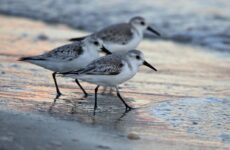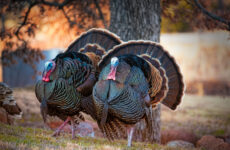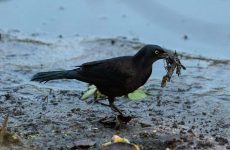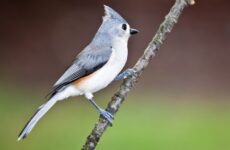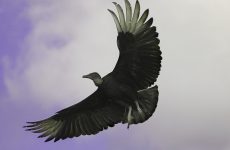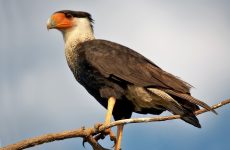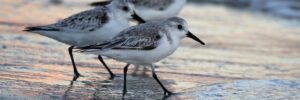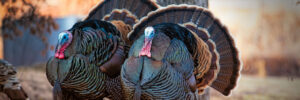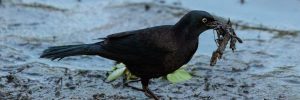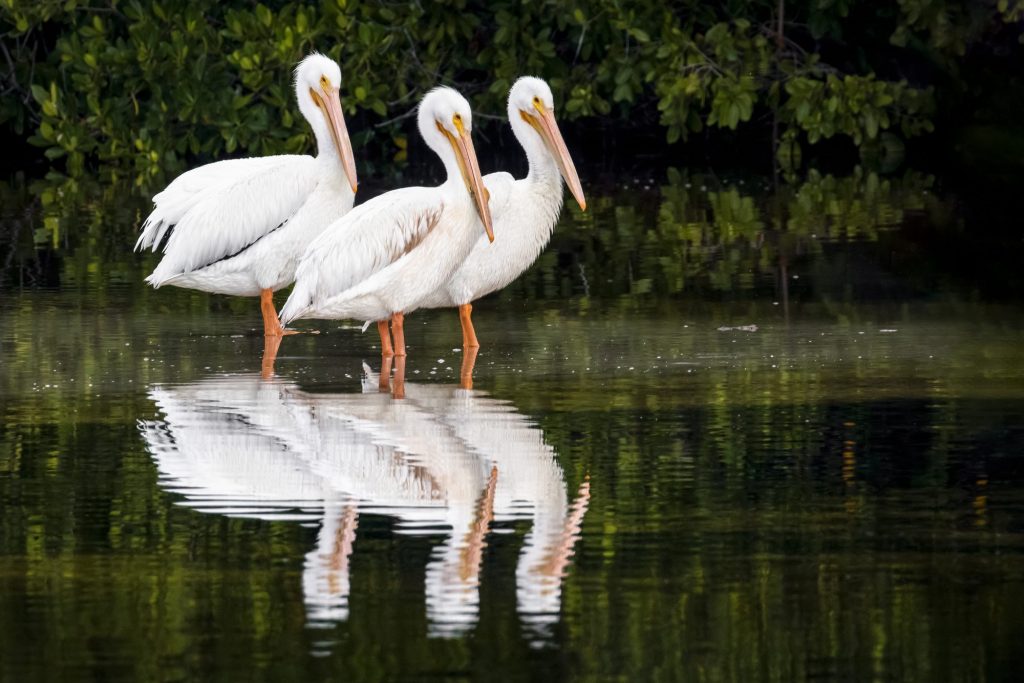
From egrets to Snowy Owls there is something mesmerizing about white birds that means you can’t quite take your eyes off of them and want to know more.
But there are so many similar-looking white birds, especially egrets, herons, and ibis. So how do you know which is which?
Well, you have come to the right place as this guide will help you identify white birds by sight and sound and know which times of the year they are in Georgia to help you narrow down the options and find out more about birds near you.
White Birds In Georgia By Season
White Birds in Georgia all year: Great Blue Heron, Great Egret, Rock Pigeon, Snowy Egret, Little Blue Heron, White Ibis, Wood Stork, Mute Swan
White Birds in Georgia in summer: Cattle Egret, Swallow-tailed Kite, Common Tern
White Birds in Georgia in winter: Ring-billed Gull, American White Pelican, Northern Gannet, Snow Goose, Ross’s Goose, Tundra Swan
This guide will help you identify those white birds out on the water or in the woods or fields and are listed from most to least common according to checklists submitted by bird watchers on ebird for Georgia.
17 White Birds In Georgia
1. Great Blue Heron
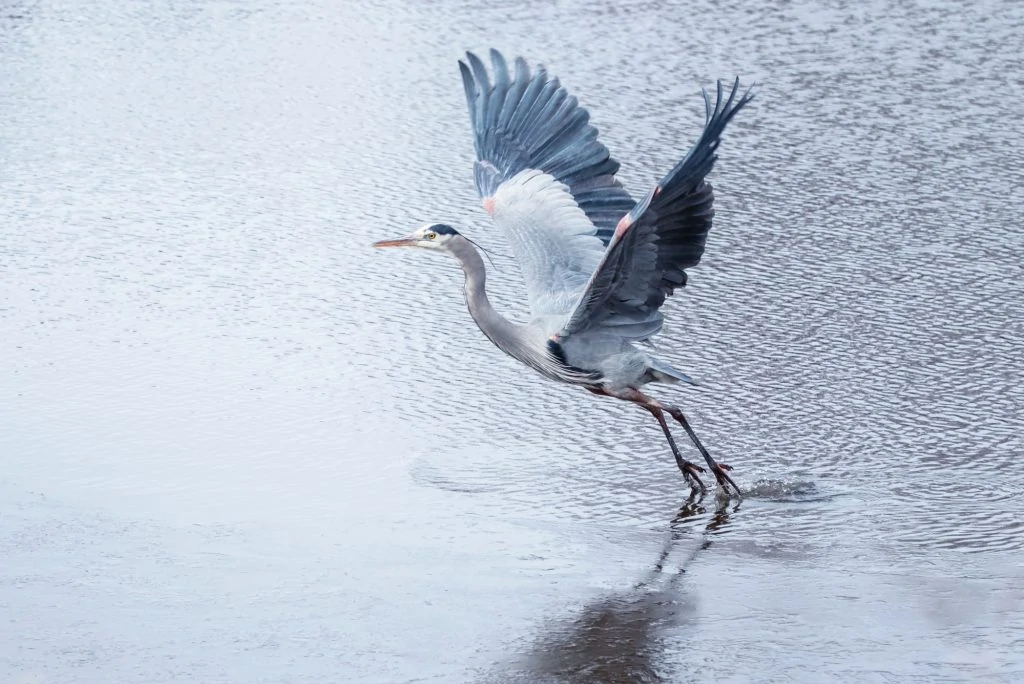
Great Blue Herons are very common in Georgia and are spotted in the state all year. They are recorded in 15% of summer and winter checklists submitted by bird watchers for the state.
Great Blue Herons are very large, majestic birds that are the largest heron native to North America. Their pale gray bodies can look white in flight.
They have a white face with a black crest or plume that extends from the front of their eyes to the back of their heads. Their bills are yellow-orangish.
They have long gray necks with black and white streaking in the front, pale grayish-blue bodies with dark wingtips, and long gray legs.
The Great Blue Heron has a white morph subspecies called the Great White Heron in Florida.
- Ardea herodias
- Length: 46 – 52 in (117 – 132 cm)
- Weight: 128 oz (3628 g)
- Wingspan: 77 – 82 in (196 – 208 cm)
Great Blue Herons remain in most US states all year, but those that breed in the Mid-West and Canada migrate south.
You can find Great Blue Herons in many wetland environments. They can be present in fresh and saltwater marshes, mangrove swamps, flooded marshes, lake edges, or shorelines.
Great Blue Heron Call:
Fun Fact: Great Blue Herons defend their feeding territory with dramatic wing outstretched displays, with their heads thrown back.
2. Great Egret
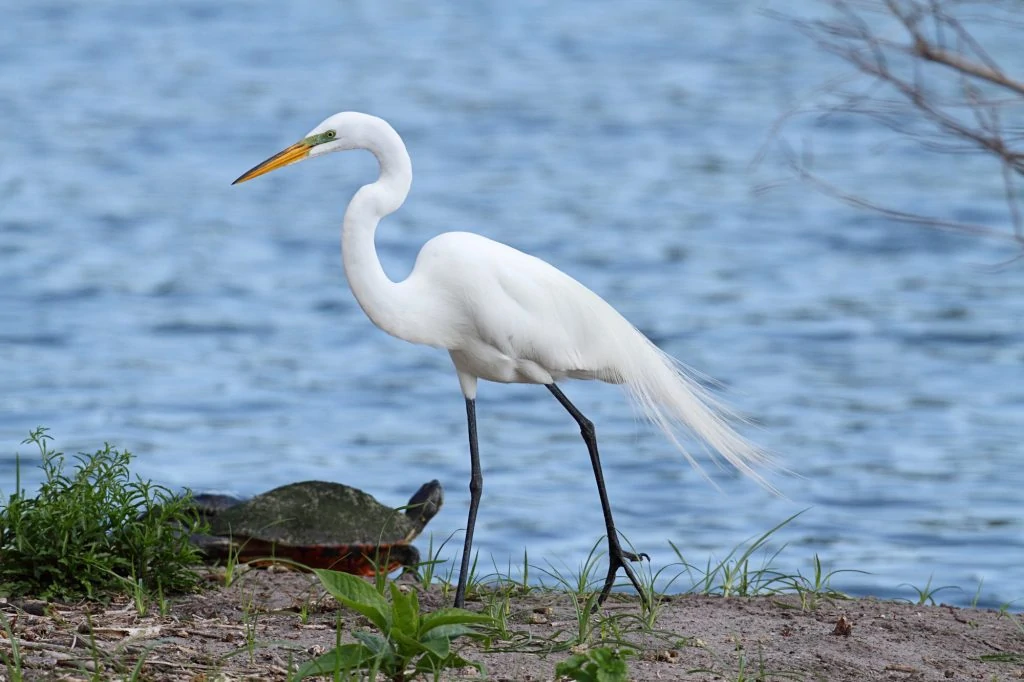
Great Egrets are spotted in Georgia all year. They are common here and appear in 10% of summer and winter checklists.
Great Egrets are at their best during the breeding season when males have neon green facial skin and long, wispy feathers (aigrettes) extending from their backs to their tails, which they show off during courtship, like how a peacock flares out its tail.
They are large, all-white herons, which is why they’re often called Great White Herons. They are also called common egrets. These large birds are white, with dagger-like, long, bright yellow bills and long, black legs and feet.
Non-breeding males, females, and juveniles look alike.
- Ardea alba
- Length: 37 – 41 in (94 – 104cm)
- Weight: 59.96 oz (1699 g)
- Wingspan: 54 – 55 in (137 – 140 cm)
Great Egrets have a vast range around the world. Those in the southern and coastal US states remain all year, but those more inland and in Canada migrate south.
You can find Great Egrets in freshwater and saltwater marshes and tidal flats, but also fish ponds.
Great Egret Calls:
Fun Fact: The Great Egret was almost hunted to extinction because of their long white feathers (aigrettes) that were mainly used to decorate ladies’ hats.
3. Rock Pigeon
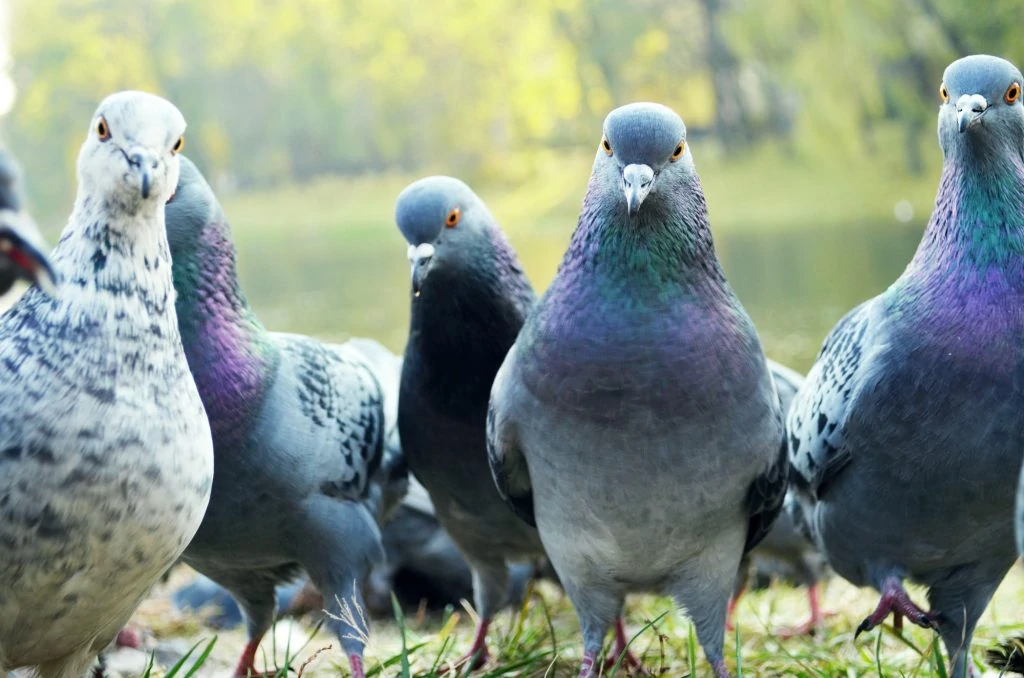
Rock Pigeons are an introduced species in Georgia and they are residents of the state all year. They occur in up to 7% of summer and winter checklists.
Rock Pigeons are well recognized around towns and parks and are usually blueish gray with two black bands on the wing and black on the tail tip. They have iridescent throat feathers and orange eyes.
However, they can also be white, spotted, or red.
- Columba livia
- Length: 11.8-14.2 in (30-36 cm)
- Weight: 9.3-13.4 oz (265-380 g)
- Wingspan: 19.7-26.4 in (50-67 cm)
Rock Pigeons do not migrate and can be found in all US states, southern Canada, and the Pacific Coast to Alaska.
You can find Rock Pigeons in cities, parks, and backyards, especially if there is birdseed on the ground. Some cities have ordinances against feeding pigeons as they are considered pests.
Rock Pigeon Call:
Fun Fact: Rock Pigeons have an amazing ability to find their way home using the earth’s magnetic field.
4. Snowy Egret
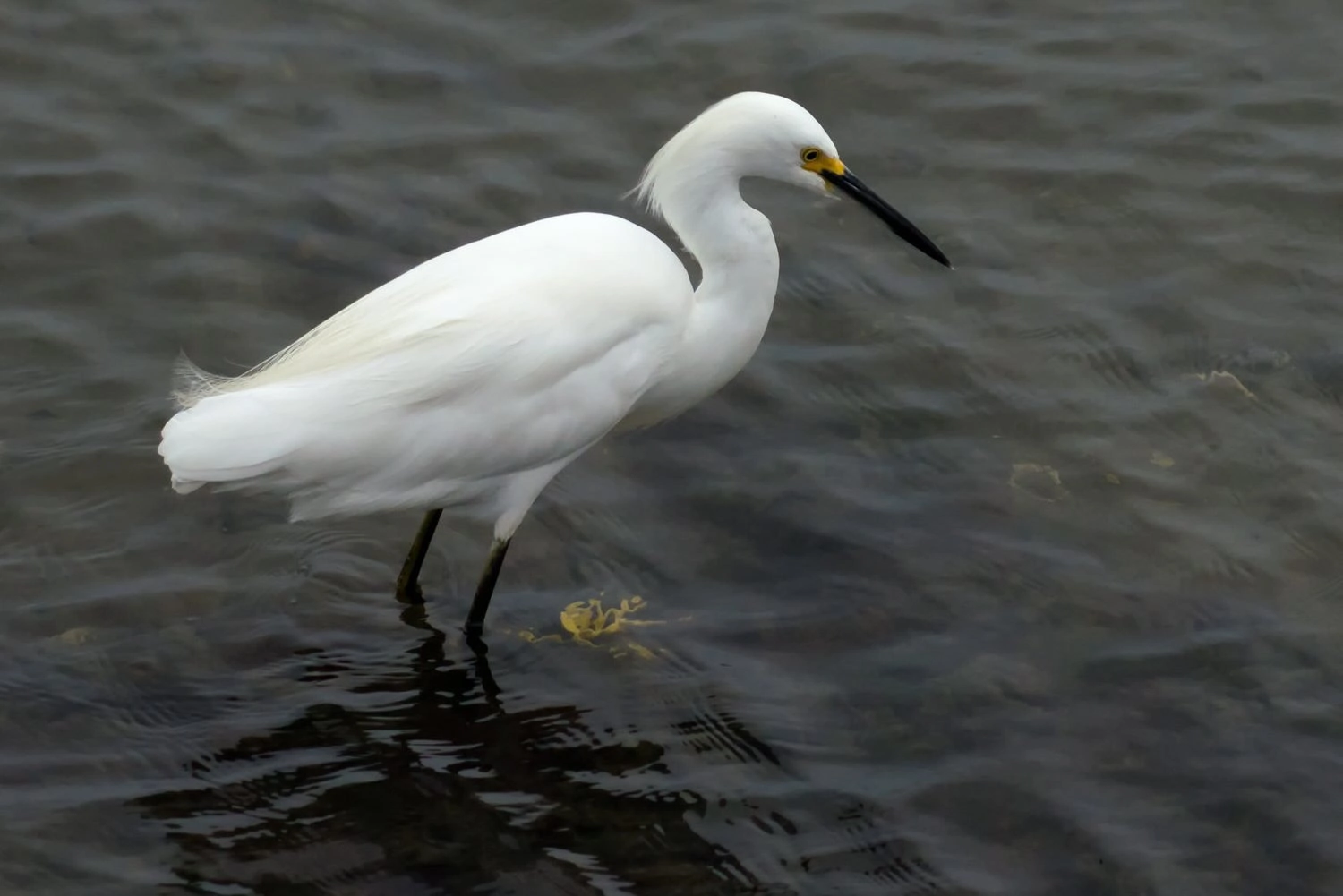
Snowy Egrets are spotted in Georgia all year and are most common from July to October. They are recorded in 5% of summer checklists and 3% of winter checklists.
Snowy Egrets, as their name suggests, are small, all-white herons. They have yellow irises and skin around their eye, long, black bills, long, black legs, and bright yellow feet.
During the breeding season, long, lacy feathers appear on their heads, necks, and backs. Their lores or facial skin turn reddish-pink, and their toes turn orange-red during courtship.
Interestingly, these areas of their bodies also become bright red during aggressive encounters.
Juveniles are similar to adults but without head plumes. The colors on their bills and legs are also lighter, with lores and legs more greenish-yellow.
- Egretta thula
- Length: 22 – 27 in (56 -69 cm)
- Weight: 16.75 oz (475 g)
- Wingspan: 39.4 in (100 cm)
Snowy Egrets migrate from most US states, except along the Gulf Coast and southwest coast. They remain all year in Mexico, Central, and South America.
You can find Snowy Egrets in shallow, wetland habitats such as marshes, riverbanks, lakesides, pools, salt marshes, and estuaries. For nesting, they prefer swamp forests with protective trees and bushes.
Snowy Egret Call:
Fun Fact: Snowy Egrets were almost hunted down to extinction because of their beautiful white head feathers that were the perfect decoration or accessory to women’s hats.
5. Ring-billed Gull
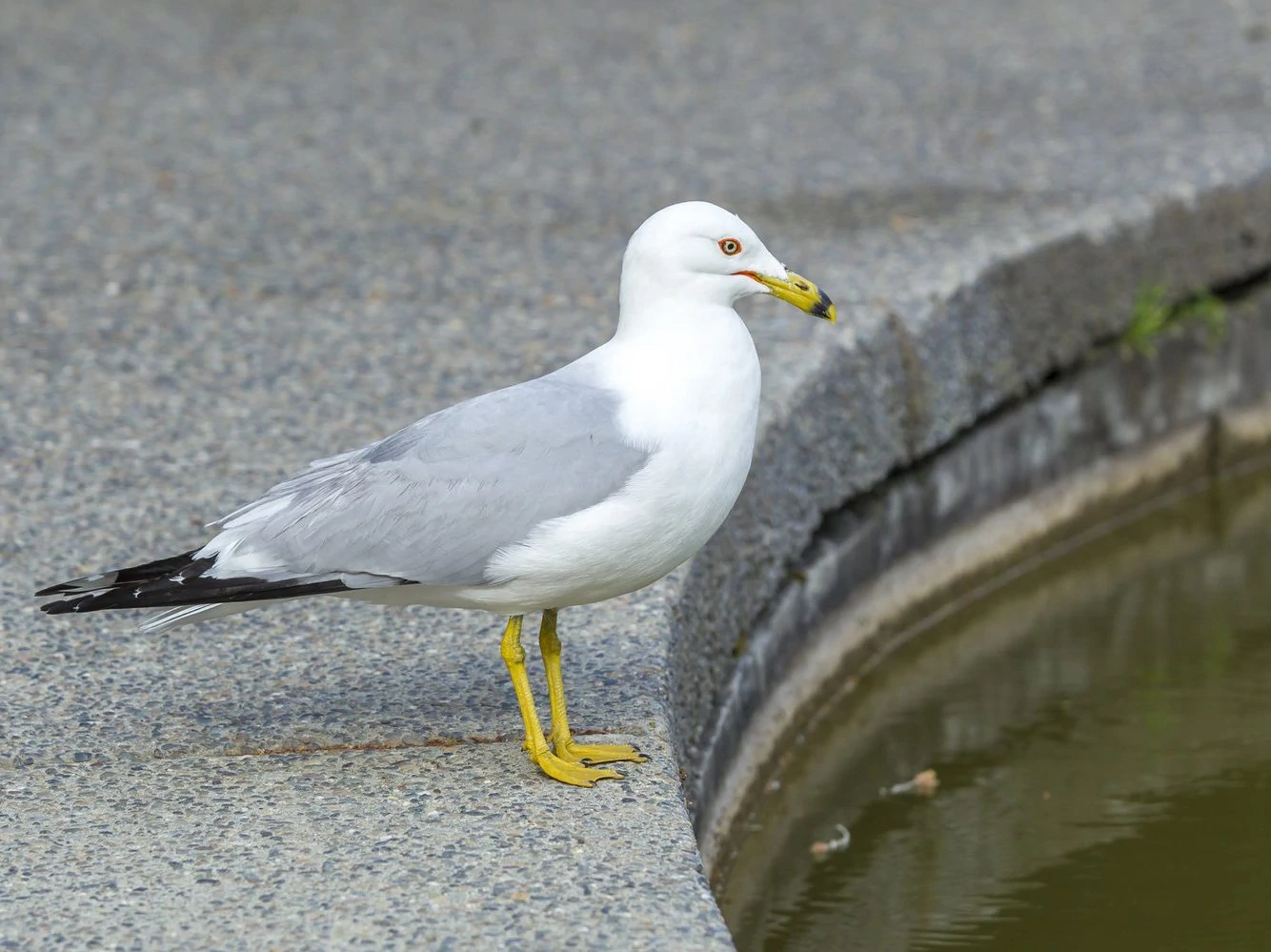
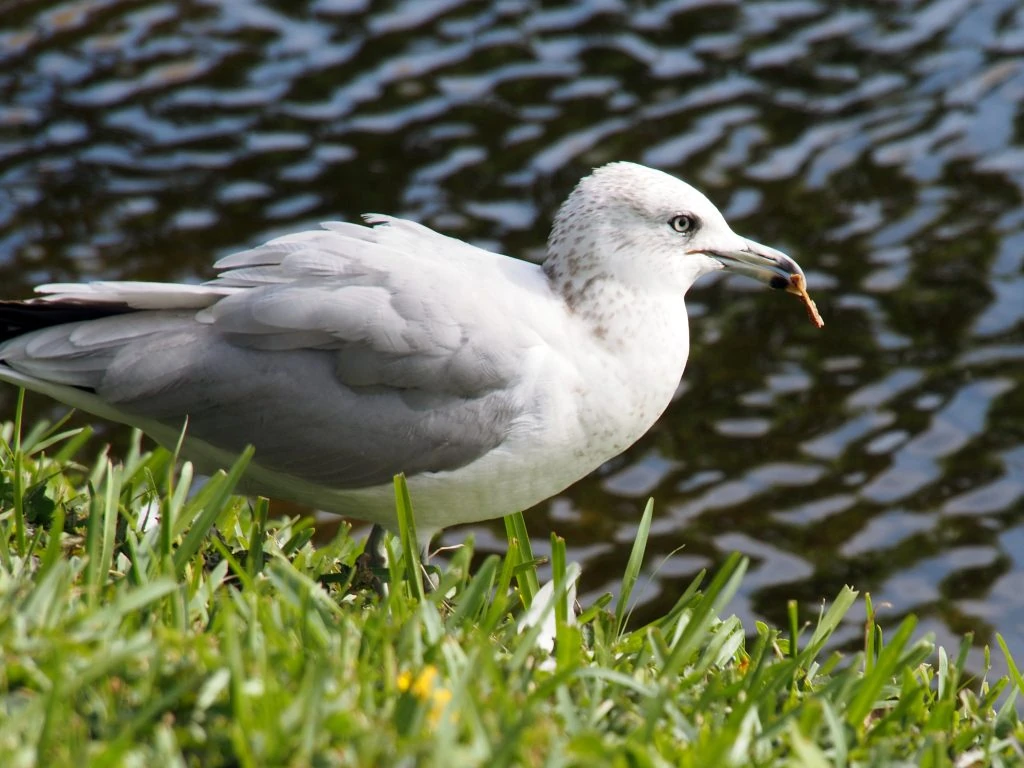
Ring-billed Gulls are spotted more in winter in Georgia all year along the coast. They appear in around 1% of summer checklists and 8% of winter checklists.
Ring-billed Gulls are medium-sized gulls that are easily identified because of their short, yellow bills with a black ring around them near the tip.
Breeding adults are generally white all-over except for their pale gray backs and wings with black tips and white spots. Their eyes are yellow, outlined with orange. They have yellow legs and feet. Males and females are similar.
The major differences between breeding and non-breeding adults are the light brown streaks on the heads and necks of non-breeding adults.
Juvenile Ring-billed Gulls are covered in brown streaks all over.
- Larus delawarensis
- Length: 18 – 19 in (46 – 48 cm)
- Weight: 20.81 oz (590 g)
- Wingspan: 47 – 48 in (119 – 122 cm)
Ring-billed Gulls breed in Canada and northern and northwestern US states. They migrate for winter to southern US states, the Pacific Coast, and Mexico.
You can find Ring-billed Gulls among many human developments – urban, suburban and agricultural areas. They also inhabit coastal waters, beaches, lakes, ponds, streams, estuaries, and mudflats. They are frequent visitors to parking lots, landfills, shopping malls, and reservoirs where they tend to group in large numbers.
Ring-billed Gulls calls:
Fun Fact: Ring-billed Gulls are sometimes called “fast food gulls” because they often hang out near fast food restaurants and scavenge for food there.
6. Little Blue Heron – Juvenile
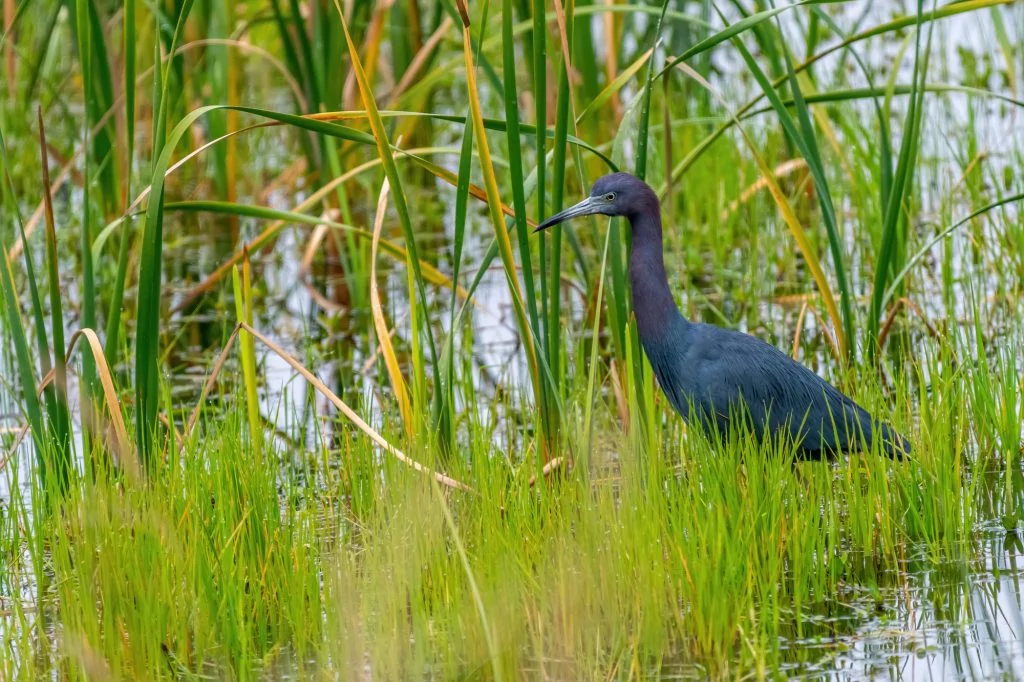
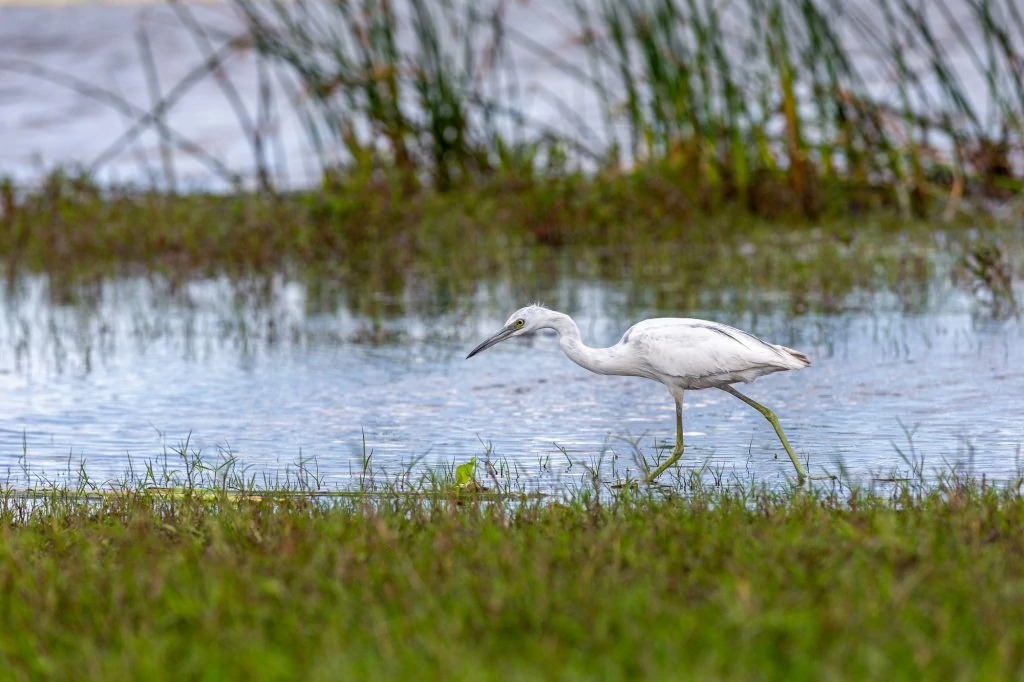
Little Blue Herons are spotted in Georgia all year and are spotted more from July to August. They occur in 5% of summer checklists and 2% of winter checklists.
Adult Little Blue Herons are actually not so little. They’re medium to large-sized with long, elongated bodies. Their heads and necks have a purplish hue with dangling feathers across the nape.
Their eyes are pale yellow and may turn gray-green during the breeding season. Their long, dagger-like bills are two-toned – pale blue or grayish with black tips. Their bodies are slate-blue. Their legs are long and black to gray-green.
Juvenile Little Blue Herons are totally white during their first year of life before becoming a mix of dark gray, blue, and white.
- Egretta caerulea
- Length: 24 – 29 in (61 – 74 cm)
- Weight: 16.22 oz (460 g)
- Wingspan: 40 – 41 in (102 – 104 cm)
Little Blue Herons breed in eastern US States before migrating south, but those along the Gulf Coast and Mexico into south America remain all year.
You can find Little Blue Herons around water, whether in swamps, marshes, ponds, streams, lagoons, tidal flats, canals, ditches, fish hatcheries, or flooded fields.
Little Blue Heron Calls:
Fun Fact: Because of the white coloring of Juvenile Little Blue Herons, their presence among Snowy Egrets so they can catch more fish and have extra protection against predators.
7. White Ibis
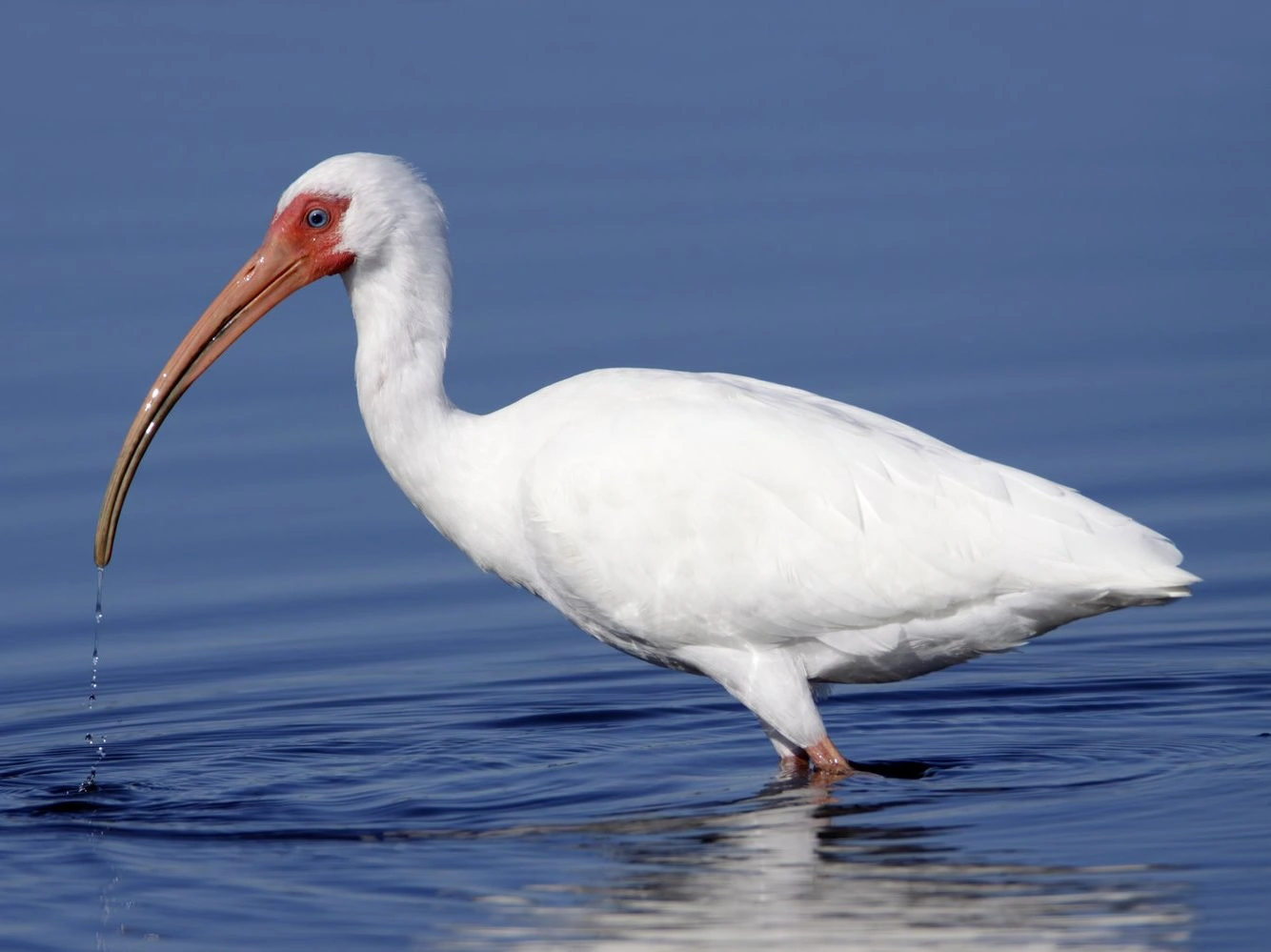
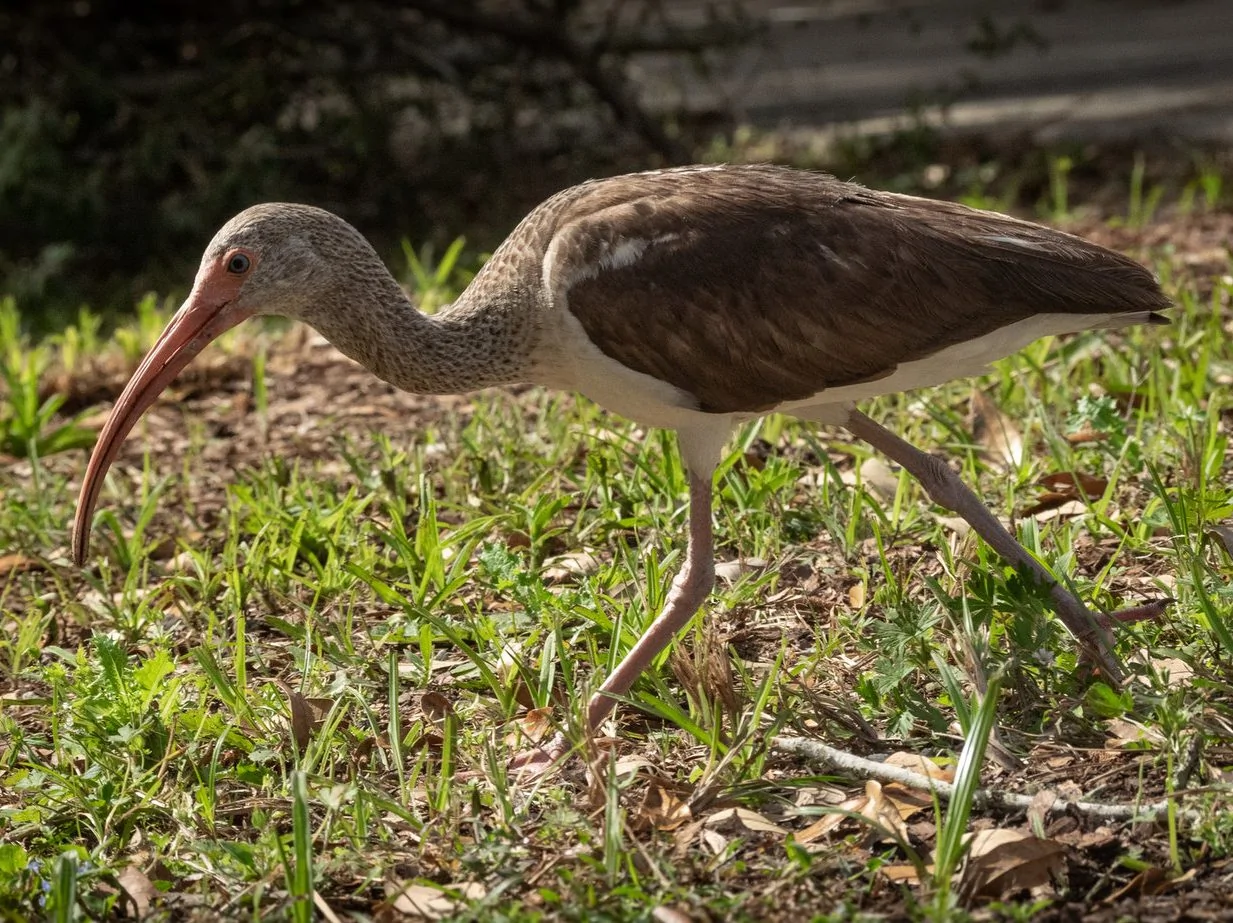
White Ibises are spotted in the south of Georgia, mainly during the breeding season but some also hang around all year. They are recorded in 3% of summer and winter checklists.
American White Ibises are medium to large-sized birds that have all-white bodies. Their distinct, bright pink facial skin, large downward-curved bill, and long legs easily identify them.
These same physical characteristics turn scarlet red during the breeding season. Their eyes are blue. They also have black tips on their wings but these can only be seen in flight.
Male and female American White Ibises look similar but juveniles are brown on their heads, wings, and back, have a pale brown streak on their necks, and they are white underneath.
- Eudocimus albus
- Length: 21 – 27 in (53 – 69 cm)
- Weight: 36.8 oz (1043 g)
- Wingspan: 21 – 27 in (53 – 69 cm)
American White Ibis are resident all year around the Gulf Coast and southern Atlantic coast but may move inland slightly during the breeding season.
You can find American White Ibises in wetland environments. They prefer freshwater marshes, coastal estuaries, mangroves, flooded pastures, mudflats, and swamps. While they wade in shallow water, they are often seen on lawns and parks.
American White Ibis Call:
Fun Fact: When American White Ibis’s prey is muddy, they will wash the mud off first before eating it.
8. Wood Stork
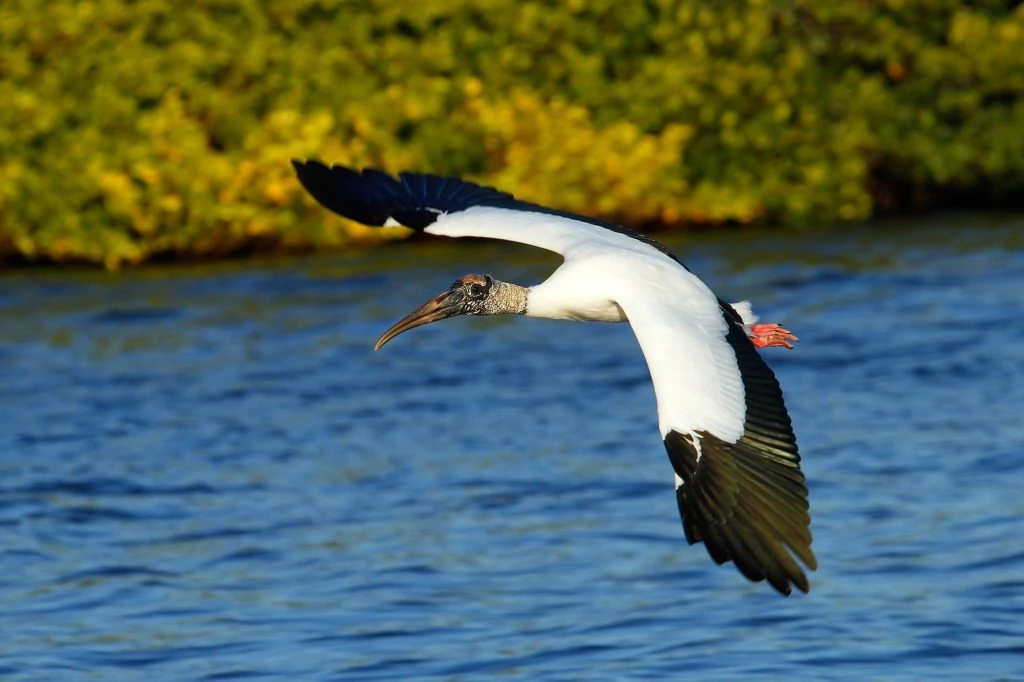
Wood Storks are spotted in Georgia all year. They are mainly found in the south of the state. They appear in up to 3% of summer and winter checklists.
Wood Storks are large wading birds that belong to the Ciconiidae family and are the only ones that breed in North America.
Their heads and necks are dark gray, scaly, and without feathers.
Their bodies are white except for the black flight feathers. Their bills are long, thick, and curved downward. Their legs and feet are dark and during the breeding season, their flesh-colored toes turn pink
Males and females look similar. Juveniles have grayish, feathered heads and pale, yellow bills.
- Mycteria americana
- Length: 35 – 45 in (89 – 114 cm)
- Weight: 96 oz (2721 g)
- Wingspan: 65 in (165 cm)
Wood Storks remain all year around the Gulf Coast and southern Atlantic coast, but may move inland for breeding. They are also found in Central and South America.
You can find Wood Storks in open forested wetlands. During the breeding season, they prefer areas with a lot of trees, especially Taxodium trees, that are along a water’s edge. Water levels should be about four to twelve inches deep for them to forage successfully.
That is why swamps, ponds, marshes, and mangrove forests are ideal places to find them.
Wood Stork Calls:
Fun Fact: Wood Storks used to be called “wood ibis” because its head looks like an ibis. It has also been known as American Wood Stork because it is found in the Americas.
9. Cattle Egret
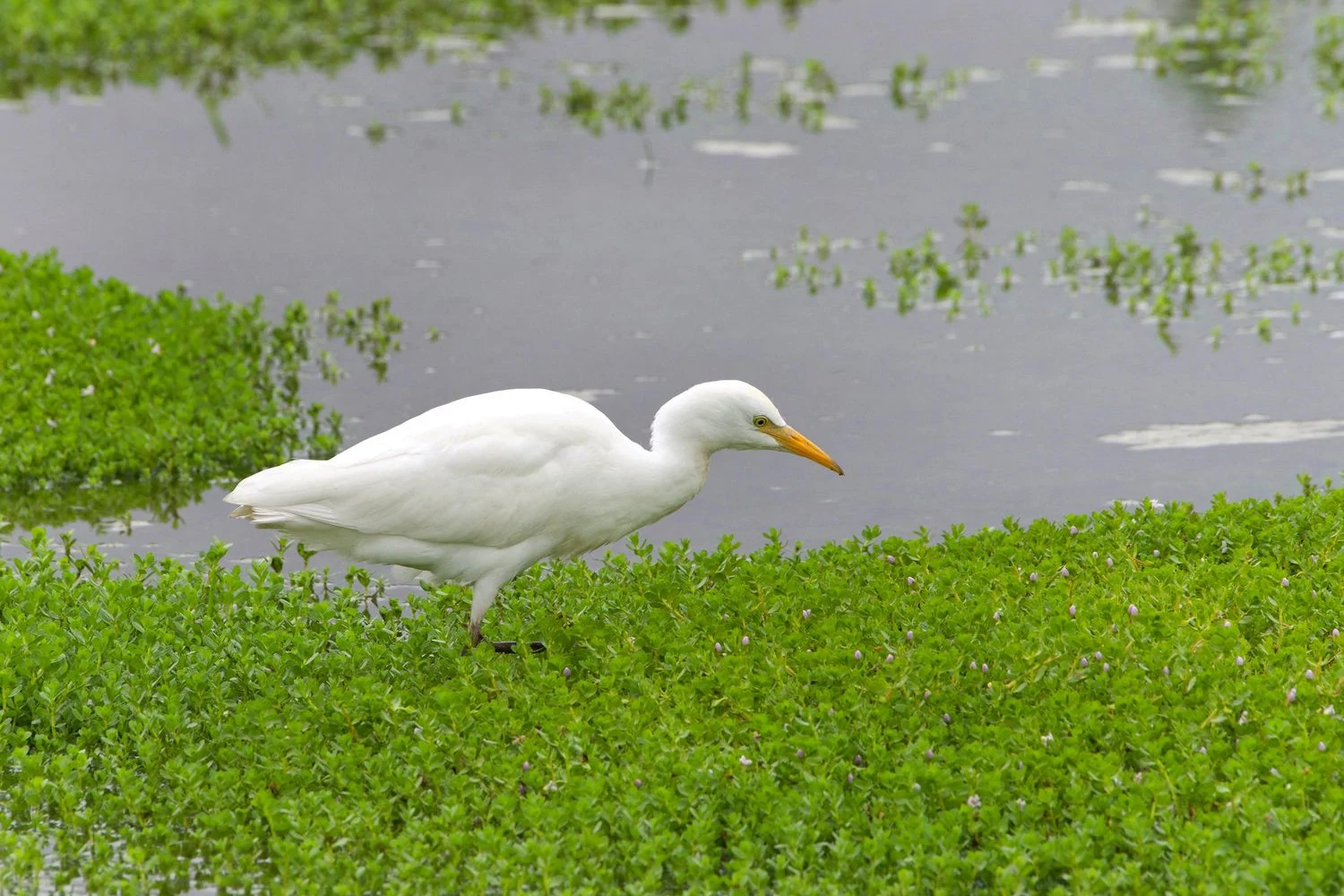
Cattle Egrets spend the breeding season in Georgia, from March to November, and occur in 4% of summer checklists. However, some hang around in the state all year.
Cattle Egrets have a smart way of catching their food…they stand on the backs of cattle, so when the cattle move and disturb the ground, they catch the disturbed prey.
Cattle Egrets are small, short-necked egrets with white bodies and pale orange-brown patches on their heads, necks, and backs.
- Bubulcus ibis
- Length: 19 – 21 in (48 – 53 cm)
- Weight: 17.98 oz (510 g)
- Wingspan: 36 – 38 in (91 – 97 cm)
Cattle Egrets have a vast range around the world, but within North America, those in the south in Mexico, the Gulf Coast, and southwestern US states remain all year.
However, those that breed further north, mainly in eastern US states, migrate south after breeding.
You can find Cattle Egrets in native grasslands, pastures, crop fields, and rice fields, especially where there is hoofed livestock.
Cattle Egret Calls:
Fun Fact: The Cattle Egret’s eyes have adapted to foraging on land by having binocular vision for judging distance to catch prey on land rather than correcting for light refraction when feeding in the water.
10. American White Pelican
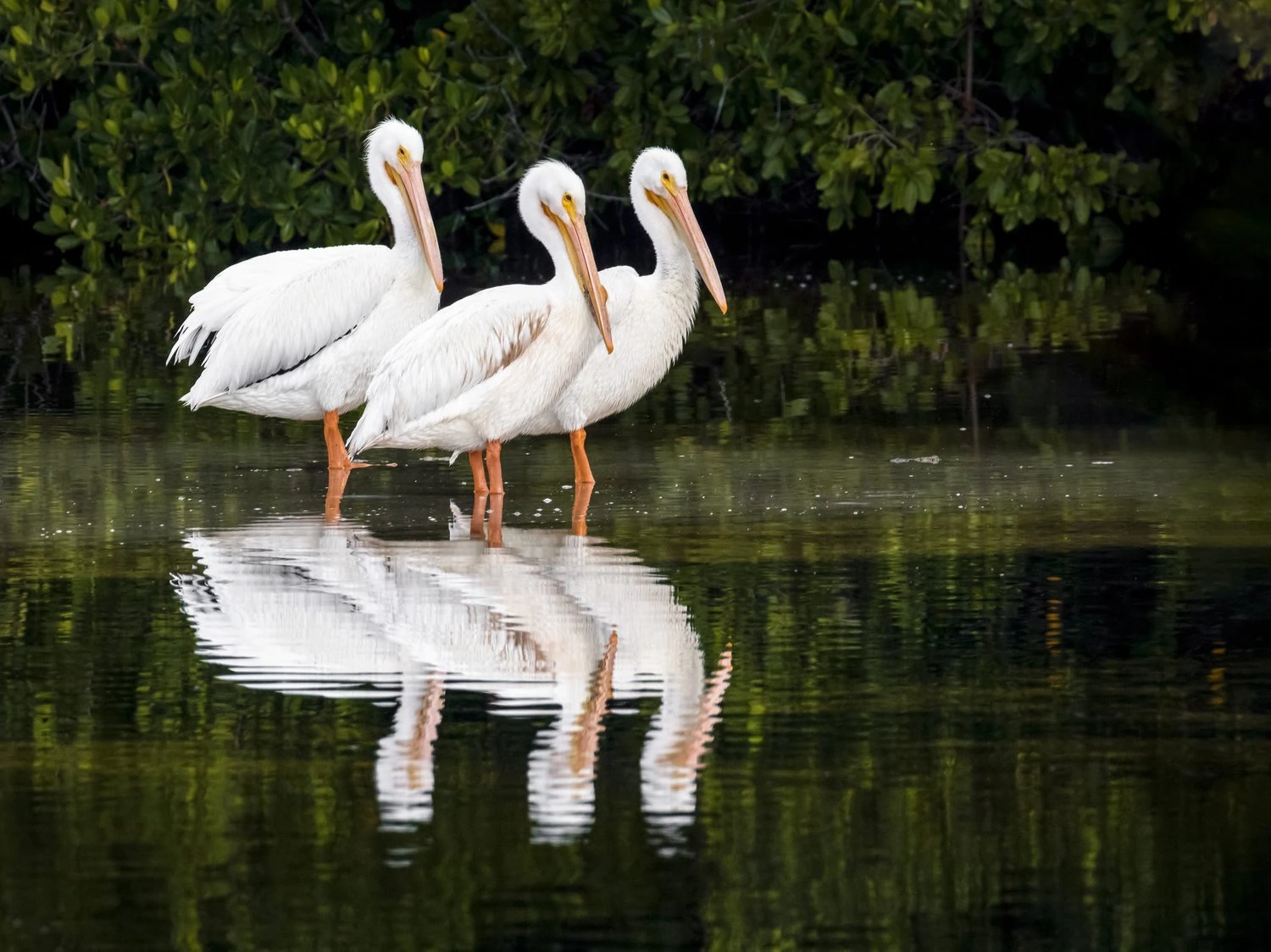
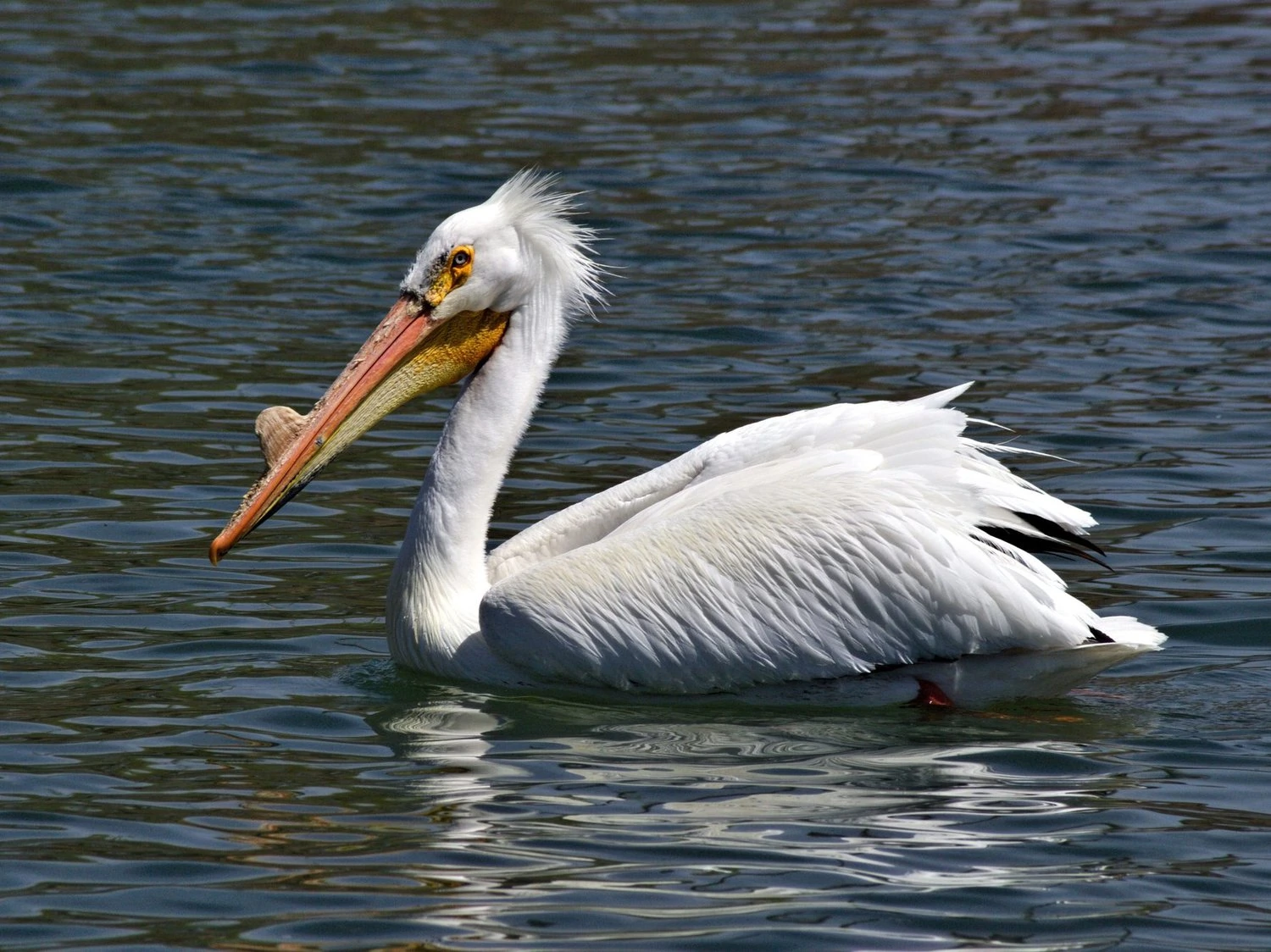
American White Pelicans are not very common in Georgia, but they can be spotted here all year, mostly during winter along the coast in the southeast of the state.
American White Pelicans are large soaring birds that have the second-largest average wingspan of any North American bird.
Non-breeding adult American White Pelicans are white all over, except for black flight feathers that are only visible when in flight or when the wings are spread. Juveniles have light gray feathers with darker brown napes.
Breeding adult American White Pelicans are still white but they grow a yellow plate on their upper bills, like a horn, and around their eyes, bills and legs become brighter orange.
- Pelecanus erythrorhynchos
- Length: 60 – 63 in (152 – 160 cm)
- Weight: 246.4 oz (6983 g)
- Wingspan: 96 – 110 in (244 – 279 cm)
American White Pelicans breed in remote lakes inland in North America before spending the winter on the southern Pacific Coast of the US, the Gulf of Mexico, Mexico, and Central America. They can be spotted during migration in western and central US states.
You can find American White Pelicans in shallow freshwater lakes, wetlands, and edges of lakes and rivers. In the winter, you can find them in coastal bays, inlets, and estuaries where they forage in shallow water and rest on sandbars.
American White Pelican calls: These birds are usually silent or only make a few grunts. However, the young can be noisy in the large colonies begging for food.
Fun Facts: The long and huge bill of the American White Pelican is capable of holding three gallons of water. When it scoops up fish from the sea, it tilts its bill down to drain the water so it can then swallow the fish that’s left inside its throat sac.
11. Swallow-tailed Kite
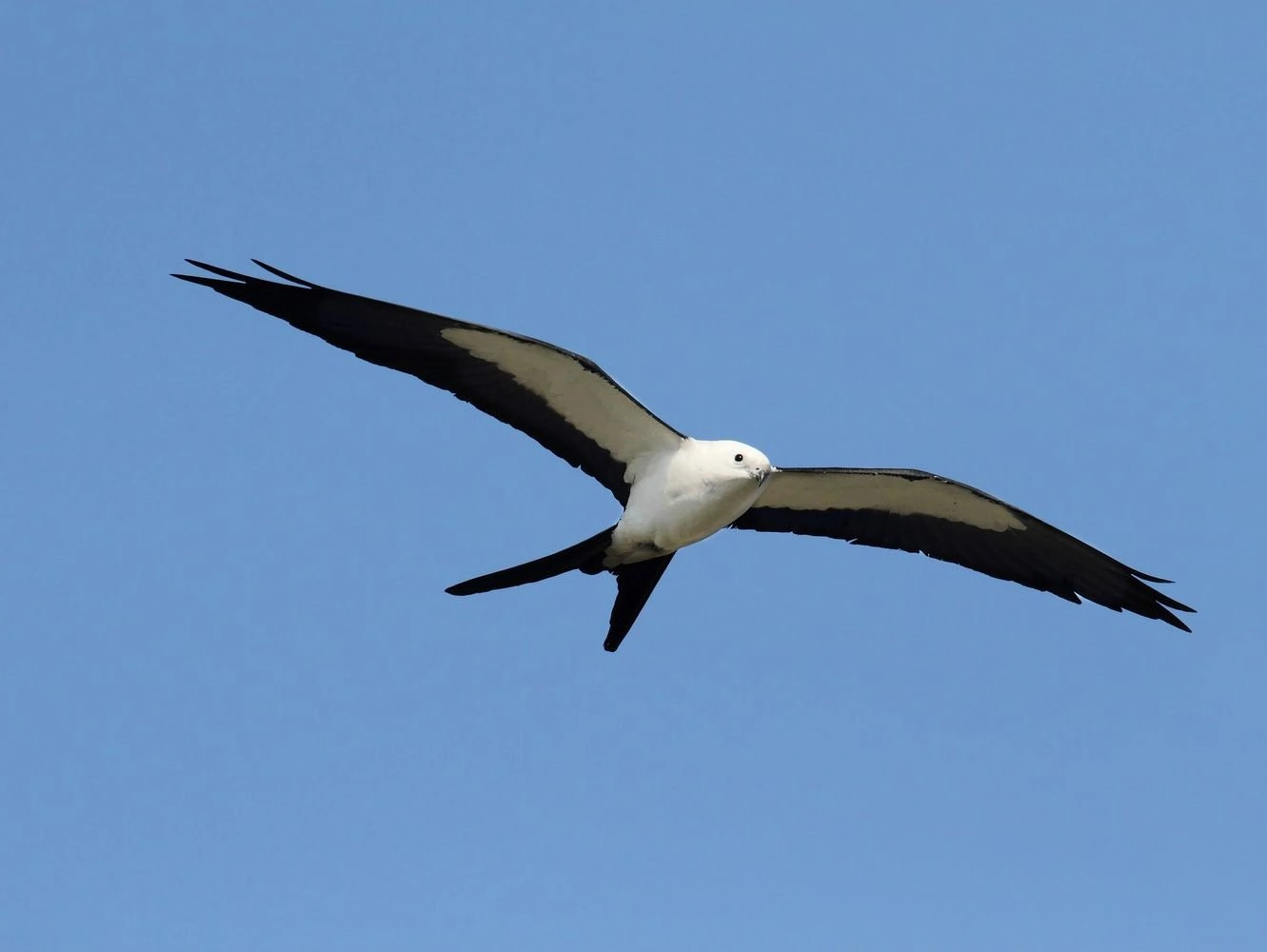
Swallow-tailed Kites spend the breeding season in Georgia and are mainly spotted from March to September. They are recorded in 1% of summer checklists.
Swallow-tailed Kites are large but slender birds of prey that are most often seen hovering in the skies with their distinctive forked tail.
Males and females look similar. They have white heads and underparts and black bills, flight feathers, tails, and feet. Their underwings are both black and white. Their long, forked tails resemble a swallow’s hence the name “swallow-tailed”.
Juveniles are paler in comparison and their tails are not that deeply forked.
- Elanoides forficatus
- Length: 19 – 25 in (48 – 64 cm)
- Weight: 15.6 oz (442 g)
- Wingspan: 45 – 50 in (114 – 127 cm)
Swallow-tailed Kites are predominantly resident in South America but they breed around the Gulf Coast of the United States.
You can find Swallow-tailed Kites in swamps, marshes, and humid, lowland forests. When nesting, look for them in tall trees around open areas with an abundance of small prey to feed their young.
Swallow-tailed Kites almost always spend their time in flight so it’s best to look skyward when looking for them. Also, summer is the best time to see them since they migrate to South America for the winter.
Swallow-tailed Kite Call:
Fun Fact: Swallow-tailed Kites are famous for their aerial acrobatics and they twist, turn, roll and dive whilst flicking their forked tail in pursuit of prey.
12. Northern Gannet
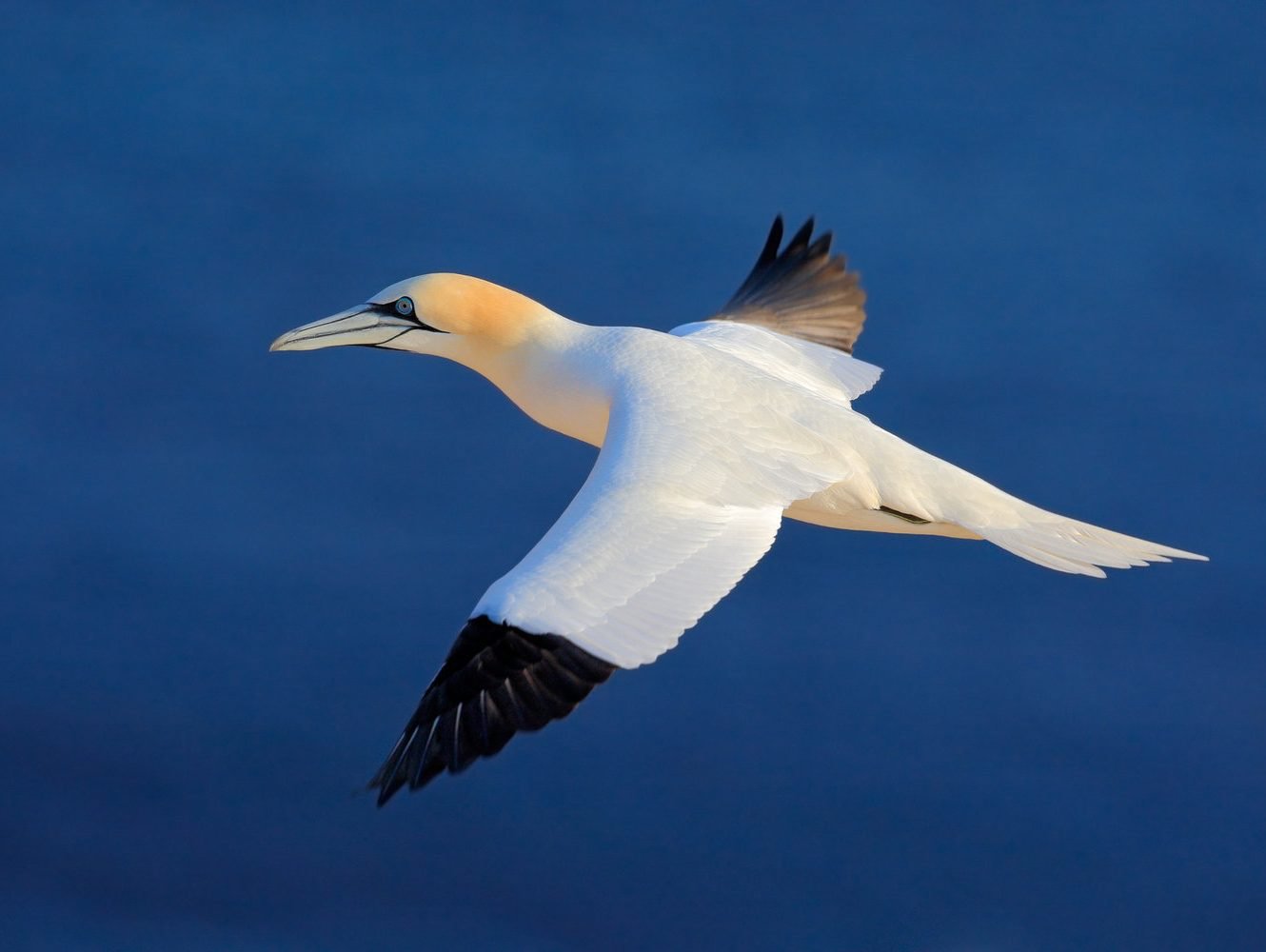
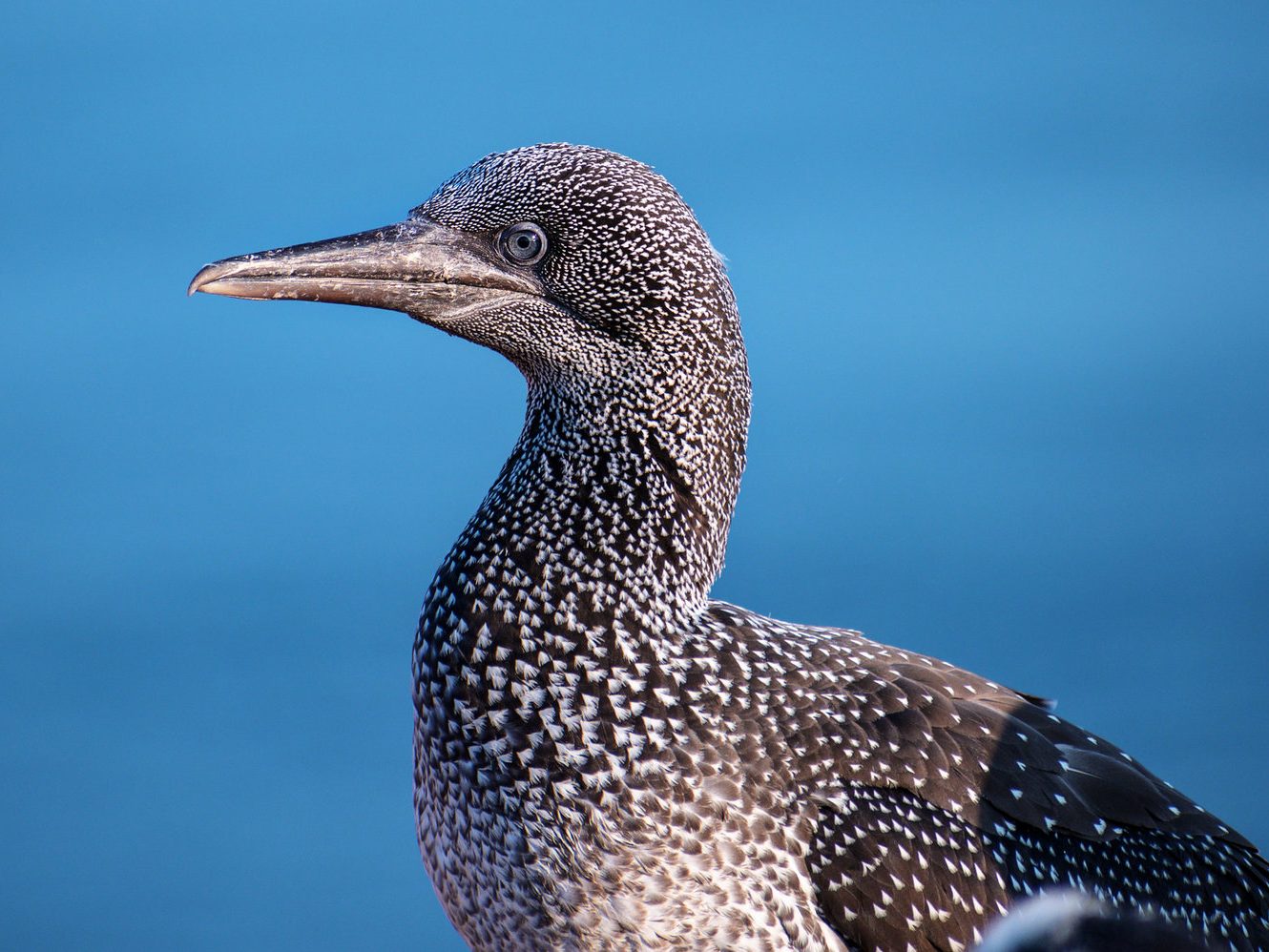
Northern Gannets are winter birds in Georgia and are spotted along the coast from October to March but some stay until mid-June. They occur in 1% of winter checklists.
Northern Gannets are the largest among the gannet family and the largest seabird in the Western Palearctic. Males and females are similar in size and appearance.
They are generally white with a yellow-orange buff tinge on their heads, which may be darker during the breeding season. Their eyes and bills appear to be outlined in black.
Their wings are long and slender and have a dark-brown or black edge. Their bills and feet are gray. Their tails are all-white.
Juveniles look nothing like the adults. They are brown overall with white spots. They also have no outline marking their eyes and bills. They have a white patch on their tails. Immatures appear as a combination of both the juvenile and adult.
- Morus bassanus
- Length: 35 – 40 in (89 – 102 cm)
- Weight: 104 oz (2947 g)
- Wingspan: 65 – 71 in (165 – 180 g)
Northern Gannets breed around coastal eastern Canada and spend the winter along the Atlantic coast of the United States. They are also found in western Europe and North Africa.
You can find Northern Gannets on the open ocean and large bays. Their nesting and breeding colonies are often on cliffs and rocky ledges of the Canadian Atlantic Coast. Bonaventure Island in Quebec is the largest colony in North America with 60,000 nests as of 2009.
Northern Gannet Calls:
Fun Fact: It takes Northern Gannets five years to fully grow into their adult physical appearance.
13. Common Tern
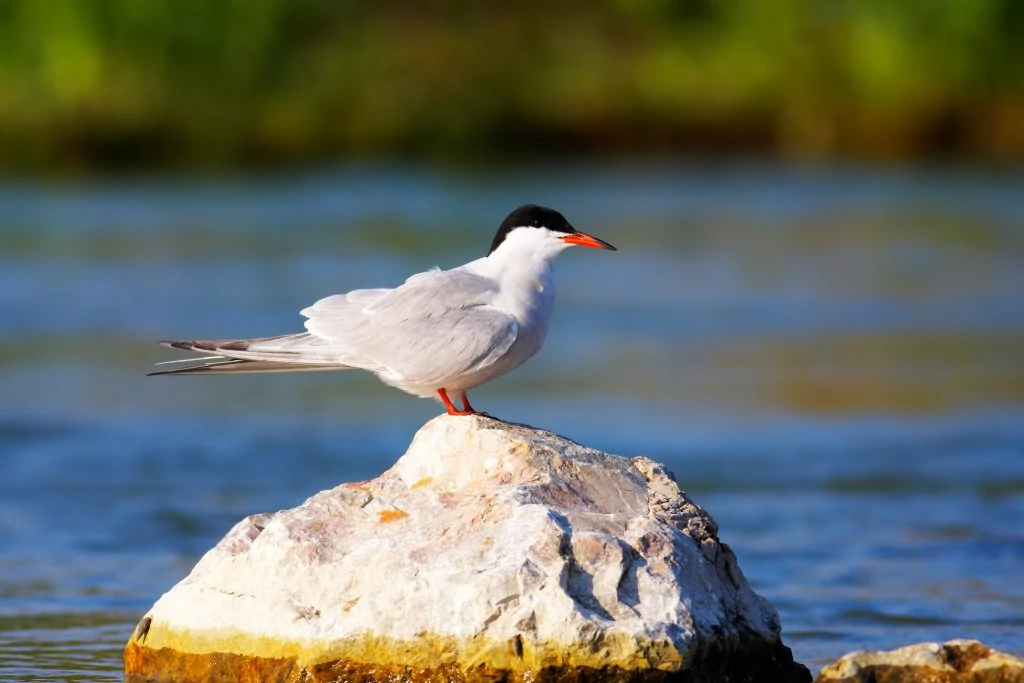
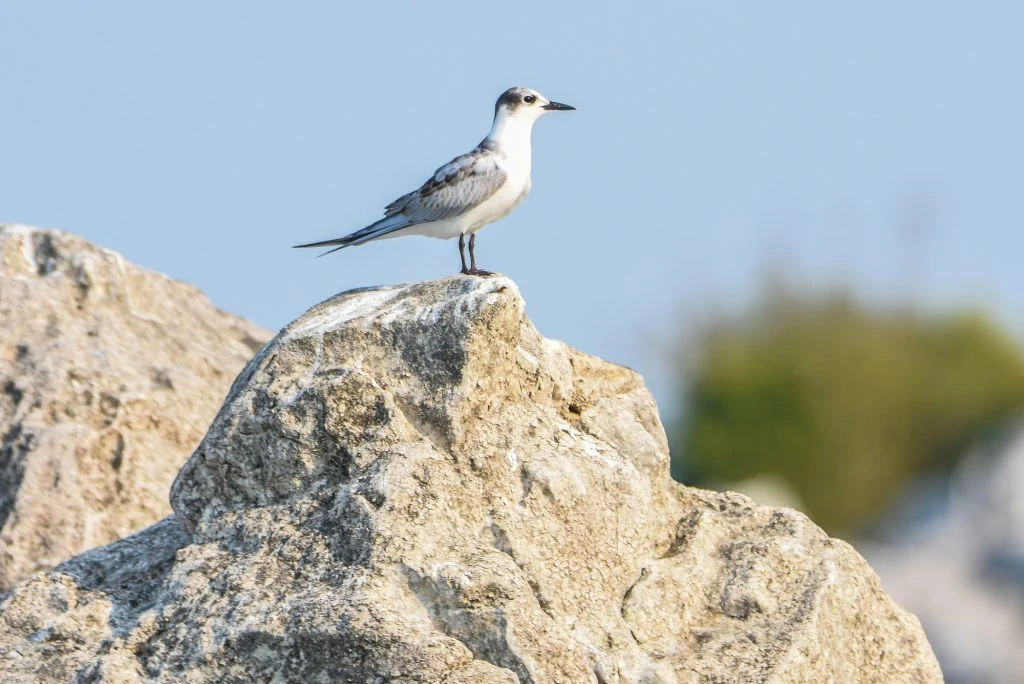
Common Terns are spotted along the coast of Georgia and are mainly spotted from August to October.
Common Terns are small to medium-sized seabirds considered one of the most widespread terns in North America.
Breeding Common Terns have distinct black caps and napes, white necks and chests, orange bills with a black tip, soft gray bodies which are lighter underneath, and orange legs. Their wings are dark-tipped and form a dark wedge on the upperside of the wingtips. Their tails are white and deeply forked.
Non-breeding adult Common Terns lose the front portion of their black caps and are left with white foreheads. Their bills and legs turn black.
Juveniles are a pale version of non-breeding adults.
- Sterna hirundo
- Length: 13 – 16 in (33 – 41 cm)
- Weight: 5.15 oz (146 g)
- Wingspan: 30 – 31 in (76 – 79 cm)
You can find Common Terns close to the water (whether freshwater or saltwater) as long as it’s in any open flat habitat like sand or shell beaches, firm dune areas, salt marshes, or islands during their breeding season.
In winter, Common Terns occur anywhere that has access to fish. They may be on natural sand and shell beaches, marine habitats, estuaries, and large inland lakes. They are also known to rest on boats, buoys, and piers.
Common Tern calls:
Fun Facts: In the 19th century, there was a huge decrease in the population of Common Terns due to fashion. Entire stuffed Common Terns were used to make hats in Europe and North America.
14. Snow Goose
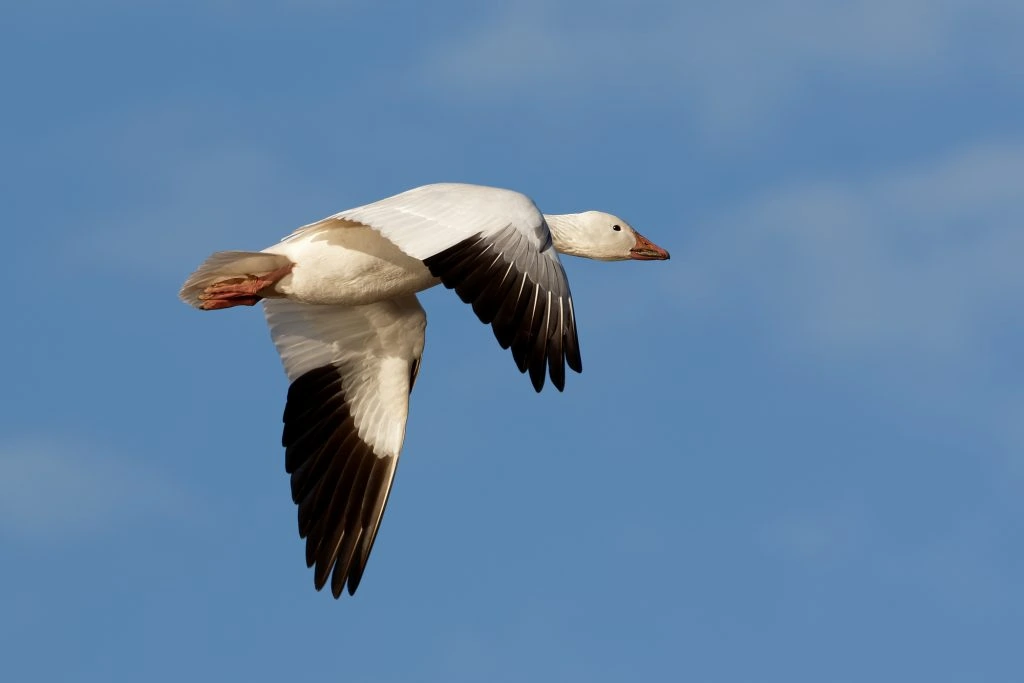
Snow Geese are not very common in Georgia but they are mainly spotted from November to January. Some can also be spotted in the state all year.
The Snow Goose is aptly named because this goose is totally white except for its black wingtips, pink bill with a black grin patch, and pink legs and feet.
Interestingly, it has another variant, called the Blue Goose, which has a white head but a dark blue-gray body. Both variants of the Snow Geese may occasionally have a “stained” head due to their feeding.
The sexes of both variants are similar though they may vary in size. Males tend to be larger than females.
Juvenile white morphs have a dusky gray-brown coloring, and juvenile blue morphs are dark gray. However, they both still have the recognizable pink bill and black grin patch.
- Anser caerulescens
- Length: 25 – 31 in (64 – 79 cm)
- Weight: 81.13 oz (2299 g)
- Wingspan: 54.3 in (138 cm)
Snow Geese breed mainly in Canada and spend winter in the United States.
You can find Snow Geese and Blue Geese together in freshwater marshes and agricultural grain fields. In winter, they favor salt marshes and coastal bays, but they still visit plowed cornfields or wetlands.
Snow Goose Call:
Fun Fact: Snow Geese choose the same color morph as themselves when breeding and will mate for life.
15. Ross’s Goose
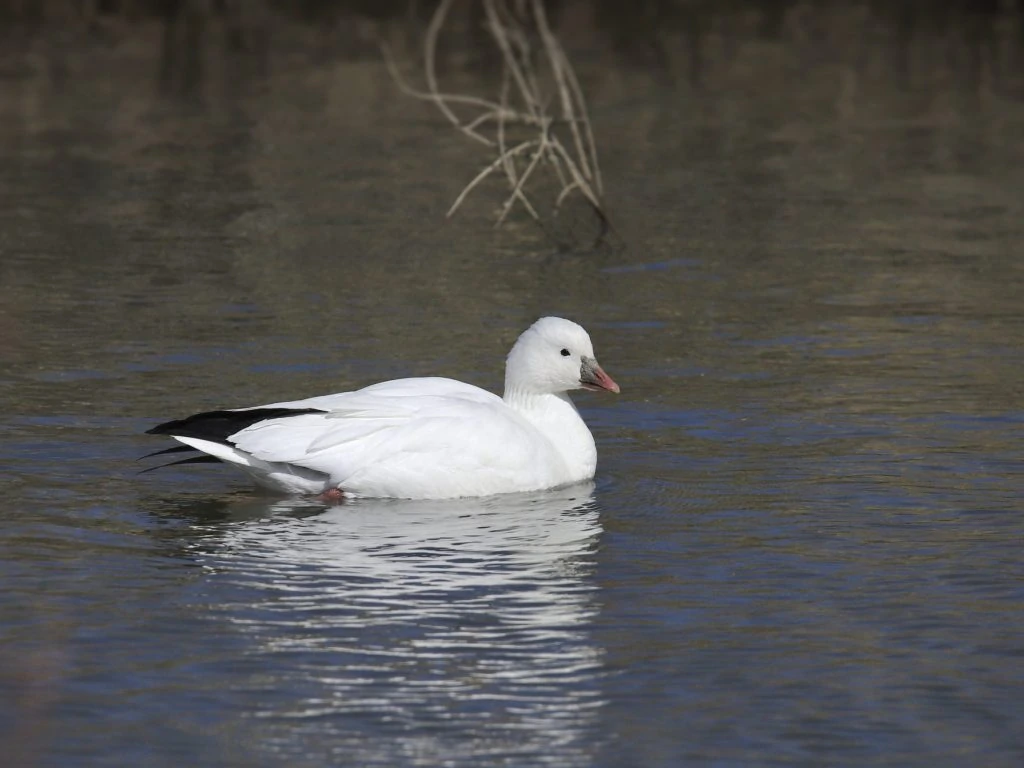
Ross’s Geese are not often spotted in Georgia, but you might spot some during winter, from November to May.
Ross’s Geese are pretty similar to Snow Geese, whom they often flock with. They are white all over except for their short, gray-based red-orange bills, short and stubby, pink-red legs and feet, and black wingtips. Both sexes are similar, but the female is slightly smaller.
There is a dark phase variant of Ross’s Goose, but it’s extremely rare. It has a white head, a brownish bill with a red patch, dark gray throats, underparts, and back.
- Anser rossii
- Length: 21 – 26 in (53 – 66 cm)
- Weight: 59.2 oz (1678 g)
- Wingspan: 47 – 54 in (119 – 137 cm)
Ross’s Geese breed in northern Canada and spend the winter in the United States.
You can find Ross’s Geese in salt and freshwater marshes during winter. During the breeding season, they will nest on the arctic tundra.
Ross’s Goose Call:
Fun Fact: Ross’s Geese are the smallest geese in North America.
16. Mute Swan

Mute Swans are non-native species in Georgia that can occasionally be spotted here all year.
Mute Swans are one of the largest and heaviest flying birds. They are non-native and were introduced to grace ornamental lakes and ponds but now have escaped into the wild and bred. They cause problems for native wildlife and can be aggressive.
They are entirely white, with long, graceful necks, orange bills with a large, black basal knob, black around the base of the bill, and black legs. Adults look alike, although males are larger than females.
Juveniles don’t have orange-colored bills. Instead, they have dusky-pinkish bills. They may occasionally have dusky-brownish highlights on their body.
- Cygnus olor
- Length: 56 – 62 in (142 – 157 cm)
- Weight: 416 oz (11789 g)
- Wingspan: 84 – 96 in (213 – 244 cm)
Mute Swans were originally from Europe but have spread to the United States and southern Canada. They are predominantly found in eastern US states but smaller populations are now widespread.
You can find numerous Mute Swans in city parks, protected bays, and lakes. You may also find them in shallow wetlands, rivers, and estuaries.
Mute Swans Call:
Fun Fact: Adult swans are highly protective of their young and will aggressively defend them when they sense danger or threats. They will hiss as a warning and will immediately chase and attack the predator if the warning is ignored.
17. Tundra Swan
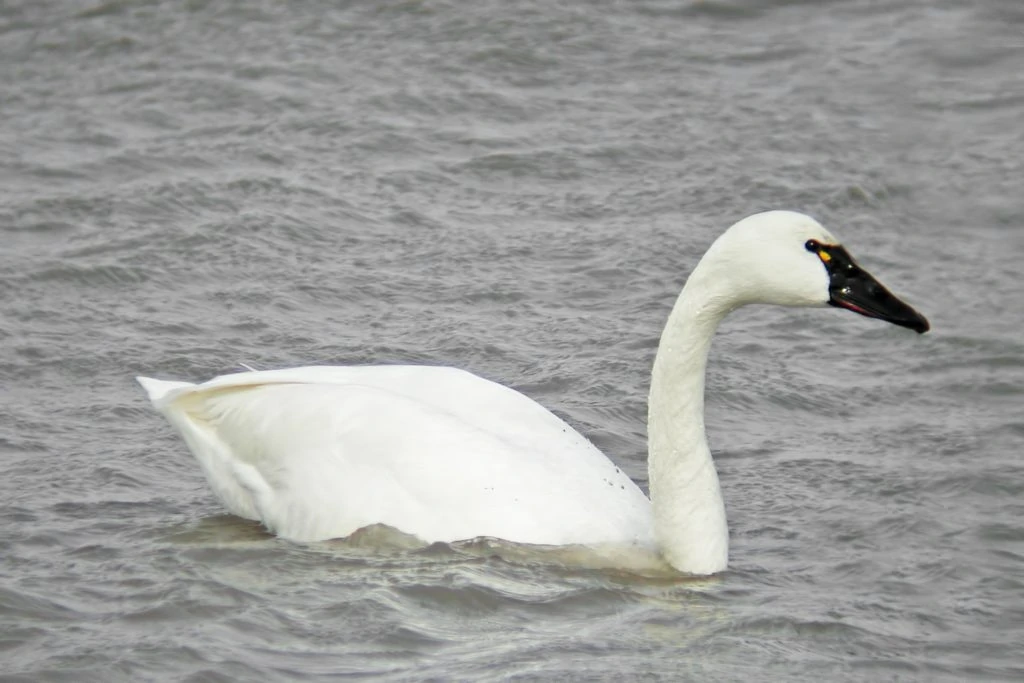
Tundra Swans are usually spotted in Georgia during winter, from mid-November to February, but they are not very common here.
Tundra Swans are identifiable because of the yellow patches at the base of their bills, but sometimes these do not appear. They have entirely white bodies with long necks and black bills, legs, and feet.
Juvenile Whistling Tundra Swans are pale brown with white highlights and a mostly pink bill with a black tip and base.
- Cygnus columbianus
- Length: 487 – 58 in (119 – 147 cm)
- Weight: 370.37 oz (10496 g)
- Wingspan: 72 – 84 in (183 – 213 cm)
Tundra Swans breed predominantly in Alaska and Canada before migrating to the United States for winter.
You can find Tundra Swans, as their name suggests, in Arctic tundra. They mostly form flocks in wetlands, marshy lakes, ponds, estuaries, and bays. They also flock together in agricultural fields.
Tundra Swans Call:
Fun Fact: The Tundra Swan used to be called “Whistling Swan” because of the sound their wings make in flight.
How Frequently White Birds Are Spotted In Georgia In Summer And Winter
Checklists are a great resource to find out which birds are commonly spotted in your state. These lists show which white birds are most frequently recorded on checklists on ebird in summer and winter in Georgia.
White Birds in Georgia in summer:
Great Blue Heron 14.8%
Great Egret 10.5%
Rock Pigeon 6.6%
Little Blue Heron 5.6%
Snowy Egret 5.0%
Cattle Egret 4.6%
White Ibis 3.5%
Wood Stork 3.0%
Swallow-tailed Kite 1.0%
Ring-billed Gull 0.9%
American White Pelican 0.4%
Common Tern 0.2%
Northern Gannet <0.1%
Mute Swan <0.1%
Snow Goose <0.1%
Ross’s Goose <0.1%
White Birds in Georgia in winter:
Great Blue Heron 15.9%
Great Egret 9.5%
Ring-billed Gull 8.6%
Rock Pigeon 7.0%
Snowy Egret 3.6%
White Ibis 3.2%
Little Blue Heron 2.3%
Wood Stork 2.1%
Northern Gannet 1.1%
American White Pelican 0.9%
Snow Goose 0.4%
Ross’s Goose 0.2%
Cattle Egret 0.2%
Tundra Swan 0.1%
Mute Swan 0.1%
Common Tern <0.1%
Swallow-tailed Kite <0.1%

